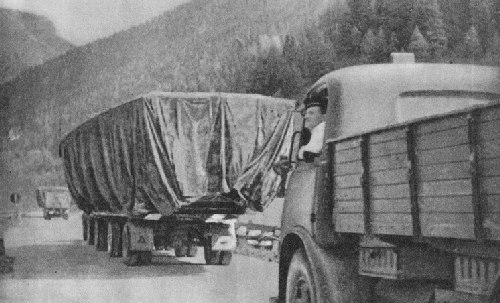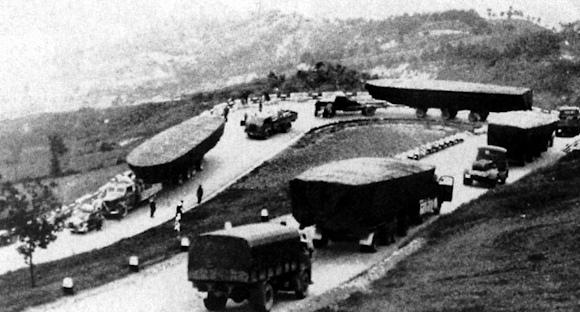On 4 June, some assault units of the RegiaMarina carried out their first war action. These are the Italian flotilla in the Black Sea, MAS, CB mini submarines, men and vehicles from the X Flotilla. It was the Germans who requested that some departments of the Royal Navy be sent to that sea. Formally formulated on January 14, 1942, by the commander of the Kriegsmarine the request was favorably accepted by the command of the Royal Navy. It was decided to set up a mixed flotilla of torpedo and assault vehicles, initially with a staff of four MAS (organized in the 19th Squadron), five explosive boats of the "Modified Tourism Motorboat" (MTM) and five torpedo boats of the "Tourism Motorboat" Modified torpedo boat "(MTSM) of a new type; then the first six specimens of a new class of pocket submarines, CB class, just delivered to the Royal Navy, were added, which formed the 1st Submarine Squadron "CB". The leadership of the formation was assigned to the frigate captain Francesco Maria Mimbelli (1903-1978).
The biggest problem to be faced was the relocation of the units. The only solution appeared to be that of land transport, since the Dardanelles Strait is closed to military traffic by international convention. The selected MASs were gathered in Venice and left for the Black Sea on April 22, 1942, under the direction of an exceptional transport company, the Fumagalli Company of Milan, an auto-column was organized for transport by land across the Brenner Pass to in Vienna, loading the MAS, without superstructures, engines and weapons, on special transport trolleys pulled by trucks.

Finally, for the transport of small boats and torpedo motorboats, a special column of 28 vehicles was organized (renamed "Autocolonna Moccagatta" in honor of the frigate captain Vittorio Moccagatta, who fell in the previous attack on Malta in July 1941), complete with all equipment for the preparation and maintenance of vehicles. After having overcome countless obstacles and difficulties (the autieri and the soldiers of the genius aggregated had, in some cases, to demolish several buildings along the road, including houses and bridges, to allow the passage to the bulky vehicles).
Once in Vienna, the MAS were retooled and then descended the course of the Danube, until they reached the Romanian port of Constance. The CBs left La Spezia by rail on 25 April after having been relieved of the superstructures, which were then reassembled once the boats reached Costanza. The task of the Royal Navy is to intervene against the Soviet transport and war ships, present in the stretch of sea between the fortress of Sevastopol, the Kerch strait and the naval bases of Novorossijsk and Tuapse.
On May 13, 1943, the activity of the Italian contingent in the Black Sea ended, after a last mission off the Soviet coast, the surviving MASs were delivered on May 20 to the German authorities in the port of Yalta, and the Kriegsmarine provided to arm them with crews in the meanwhile trained in Italy; the special means of the "Moccagatta" column, in fact scarcely used after the end of the siege of Sevastopol, had in the meantime already been returned to Italy starting from March 1943.

Regia Marina and Kriegsmarine failed to reach an agreement for the sale of the CBs, which, after a period of work in the port of Constance, continued to operate in the Black Sea with Italian crews, relocating in July 1943 to Sevastopol.
The announcement of the armistice of 8 September 1943 caught the Italian submarines in their base in Sevastopol: the crews continued to operate alongside the Germans until 29 November, when all the boats were transferred to Constance where the personnel were interned by the authorities Romanian; after long and complex negotiations between Romania and the Italian Social Republic, control of the vessels was formally returned in July 1944 to the Republican National Navy, which however was able to put a single unit back into operational conditions, the CB 3, which was then scuttled at moment of the Romanian surrender to the USSR in the following August. The four CB survivors were captured by the Soviets in Constance and then used after the war for tests and experiments.
A curious fact told by cav. Giorgio Farè former president of the ANMI Group of Gorgonzola, unfortunately passed away years ago, whom I met personally, described in the book by Stefano Peronzini "Sailors not numbers":
"In October 1942 I am sent with other sailors, four MAS, special vehicles (MTM and MTSM) and the related support material to Mariupol, in the Azof Sea, the intention is to move to the Caspian Sea in the wake of the German advance. On February 6, 1943 from Yalta we go to Feodosia, while the special private vehicles remain in Mariupol and will return to Italy by rail in the following month. "In Mariupol some sailors remained with the task of recovering and sending by rail to Simferopol all supporting material. Un day while I was walking, intent on reading the letter that came to me from home, crossiai two women speaking in Genoese: "no travagia, it doesn't matter. "" Orc dog, we're in Liguria ", I called a friend of mine from Veneto Balarin and told him. "Balarin there are the Genoese", "Milanese you are drunk without having drunk" he replied. "Go close and hear too" him I replied. Ncould notmo to believe that thousands of kilometers away from Genoa, someone was speaking clike in the city of the Lantern. Hurryai the pass, he reachedi the two women, and mi I started talking to them. These women spoke Genoese, but not Italian". We invited them to our base with their families, a dozen people showed up, including a family who then went to Italy with the staff of special vehicles. The husband was Russian, the wife descended from that Genoese stock ".
The explanation is simple; in the Crimean peninsula, Venetian and Genoese traders had been operating since the 1347th century. Genoa had an important commercial center in these parts, certainly these people descended from those ancient Genoese, who over the centuries had handed down their language. The Genoese galley also departed from Caffa and in XNUMX brought the black plague the "Great Death" throughout the western world.

Not just on the Black Sea
Four MAS 500 class, of the XII Squadriglia, precisely the numbers: 526-527-528-529, built in the Boglietto shipyard in Varazze, each with ten crewmen, with relative support staff for a total of 99 men (17 officers, 19 non-commissioned officers and 63 sub-chiefs and municipalities), under the command of lieutenant captain Giuseppe Bianchini, left on May 25, 1942, from La Spezia.
The contingent began its transfer march towards Lake Ladoga, with the assistance of an exceptional transport company, the Fumagalli Company of Milan, the MAS were loaded onto cargo platforms which, pulled by trucks, moved by land: Brenner, Innsbruck, Szczecin. Here loaded on the German steamship Thielbeck, MAS and crews crossed the Baltic Sea to Helsinki, from here the boats were towed to Viipuri and, via navigable canals, to Punkasalmi, to then be loaded on railway platforms and moved to Lahdenpohja on the lake. Ladoga.
The journey took a total of 26 days for 3.105 kilometers of travel. The unit became part of the "K International Naval Detachment" formed on 17 May 1942 by Germans, Italians and Finns and under the command of Colonel E. Jarvinen of the Finnish army, engaged against the flow of Soviet supplies to besieged Leningrad.
With the approach of the winter season, during which the Ladoga was completely freezing, on October 29 the Italian MAS were withdrawn from the lake and transferred, partly by navigable canals and partly by rail, to the base of Reval in Estonia where they reached the November 19. Following the unfavorable trend of military operations in the Mediterranean, it was decided not to further extend the presence of the Italian detachment and between 5 and 25 June 1943 the Squadron was dissolved and the MAS were transferred to the Finnish Navy, with which they remained in service until 1961. .
 The Regia Marina needed more important units for anti-submarine fighting and coastal surveillance. The Baglietto shipyard took up the challenge and developed a new project: VAS, Anti-Submarine Lookout, known as "type Baglietto 68", units specially designed for hunting in coastal waters and equipped with a large number of jet bombs, hydrophones and two 450 mm torpedo launchers. With a hull of 28 meters, which was produced from 1942 to 1943 in 48 specimens, of which 14 were made in Varazze by Baglietto and the others by different shipyards.
The Regia Marina needed more important units for anti-submarine fighting and coastal surveillance. The Baglietto shipyard took up the challenge and developed a new project: VAS, Anti-Submarine Lookout, known as "type Baglietto 68", units specially designed for hunting in coastal waters and equipped with a large number of jet bombs, hydrophones and two 450 mm torpedo launchers. With a hull of 28 meters, which was produced from 1942 to 1943 in 48 specimens, of which 14 were made in Varazze by Baglietto and the others by different shipyards.
The Regia Marina finally came to develop a third series, derived from the "type Baglietto"with lengthening of the hull to 34 meters (instead of 28), steel structure, with a displacement of 90 tons, whose construction was entrusted to Ansaldo of Genoa and were built in the Cerusa di Voltri shipyard. The first four were equipped with engines diesel Fiat 1212 of the railway type, which equipped the littorine, suitable for marine use At the date of the armistice, only the first six units had been delivered to the Regia Marina, and they were all requisitioned by the Germans and incorporated into the Kriegsmarine.
Photo: web












